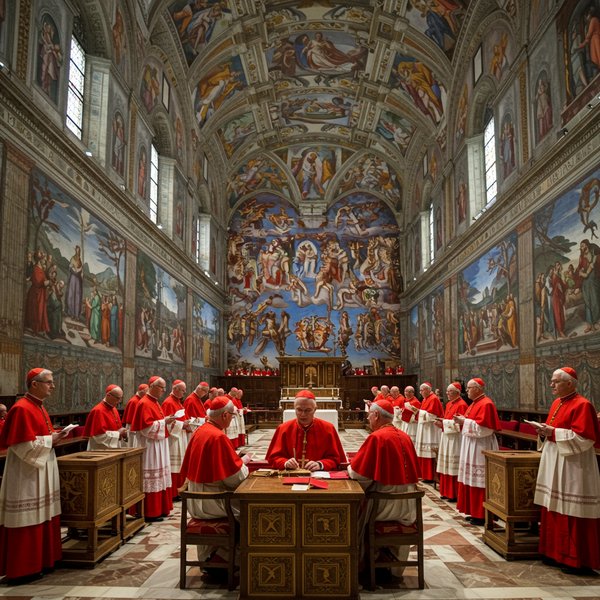Lesson
Introduction to Conclaves
Welcome to the fascinating world of papal conclaves! In this lesson, we'll explore what a conclave is, why it exists, and how it works. Conclaves are steeped in history, tradition, and secrecy. They are a critical part of the Catholic Church, and understanding them provides insight into the selection of one of the world's most influential leaders, the Pope.
What is a Conclave?
The word "conclave" comes from the Latin "cum clave," meaning "with a key." It refers to a meeting of the College of Cardinals, convened in strict seclusion to elect a new Pope. Imagine a group of important leaders locked away until they make a very important decision – that's essentially what a conclave is.

Why are Conclaves Necessary?
Conclaves exist because the Pope is the head of the Catholic Church, and when a Pope dies or resigns, a new leader must be chosen. The Catholic Church believes in a continuous line of Popes dating back to Saint Peter, so the selection of a new Pope is vital for the Church's continuity and spiritual leadership. It ensures a successor is chosen in a careful, deliberate, and prayerful manner.
Who Participates in a Conclave?
Only Cardinals under the age of 80 are allowed to participate in a conclave. Cardinals are high-ranking officials within the Catholic Church, appointed by the Pope. Limiting the voting to Cardinals under 80 is intended to ensure that those voting are still considered to be in good health and capable of fully participating in the important process.
When and Where Does a Conclave Take Place?
A conclave typically begins 15 to 20 days after the death or resignation of a Pope. This allows time for mourning, funeral arrangements, and for Cardinals from around the world to travel to Rome. The conclave is held in the Sistine Chapel in Vatican City. This iconic chapel, adorned with Michelangelo's famous frescoes, provides a visually stunning and historically significant setting for the election.
The Basic Procedures of a Conclave
The procedures of a conclave are designed to ensure a fair and prayerful election. Here's a simplified overview:
- Seclusion: Cardinals are sealed off from the outside world. They are not allowed to communicate with anyone outside the conclave, and all forms of communication (phones, internet, etc.) are strictly prohibited.
- Prayers and Reflection: The Cardinals begin with prayers and masses, seeking guidance from the Holy Spirit.
- Voting: Ballots are cast in secret. Each Cardinal writes the name of their chosen candidate on a ballot.
- Counting: The ballots are carefully counted to ensure accuracy.
- Smoking Signals: After each ballot, the ballots are burned. If no candidate receives the required two-thirds majority, black smoke is released from the chimney of the Sistine Chapel, signaling to the world that no Pope has been elected. If a Pope is elected, white smoke is released, signaling the good news.
- Acceptance: Once a candidate receives the required majority, he is asked if he accepts the role. If he accepts, he chooses his papal name.
- Announcement: The new Pope is then presented to the world from the balcony of St. Peter's Basilica with the famous phrase "Habemus Papam" ("We have a Pope!").
The Importance of Secrecy
Secrecy is paramount during a conclave. Cardinals take a solemn oath to maintain absolute secrecy about the proceedings. This is to prevent outside influence or pressure from affecting the election. The goal is to allow the Cardinals to vote freely, guided by their conscience and faith.
The Two-Thirds Majority
For centuries, the requirement for election has been a two-thirds majority of the Cardinals present and voting. This high threshold is intended to ensure that the new Pope has broad support within the College of Cardinals, fostering unity within the Church.
Historical Significance
Conclaves have a long and rich history, dating back to the 13th century. Over the centuries, the rules and procedures have evolved, but the fundamental purpose remains the same: to elect a new Pope in a fair, prayerful, and transparent manner. Each conclave is a unique historical event, shaping the future of the Catholic Church and impacting the world.
The Role of the Holy Spirit
Throughout the conclave process, the Cardinals invoke the guidance of the Holy Spirit. They believe that the Holy Spirit plays a role in guiding their decision-making, helping them to choose the best leader for the Church. Prayer and spiritual reflection are integral to the entire process.
In Summary
A conclave is a sacred and solemn event. It is a meeting of the College of Cardinals, held in strict seclusion, to elect a new Pope. The procedures are designed to ensure a fair and prayerful election, free from outside influence. The conclave plays a vital role in the continuity of the Catholic Church and the selection of its leader.
Further Exploration
This lesson has provided a basic overview of conclaves. To delve deeper into this fascinating topic, you can research the history of specific conclaves, the lives of famous Popes, and the role of the Vatican in the modern world. There are many resources available online and in libraries to further your understanding.












